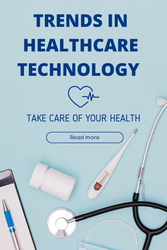Trends in Healthcare Technology
5th Feb 2025
Rapid technology breakthroughs that promise to increase accessibility, expedite medical procedures, and improve patient care are driving a seismic change in the healthcare industry. Virtual reality treatments and AI-powered diagnostics are examples of the healthcare of the future. Let's examine the top ten trends that are changing the sector.
1. Telemedicine and Virtual Care
Telemedicine gained widespread acceptance during the epidemic and is here to stay. Patients may visit doctors remotely thanks to platforms like Amwell and Teladoc, which shorten wait times and increase access to rural areas. As a result of hybrid treatment models that combine in-person and virtual visits, more than 80% of hospitals in the United States have adopted Telehealth by 2023.
2. AI and Machine Learning in Diagnostics
With technologies like Google's DeepMind and IBM Watson Health that can scan medical pictures more quickly and correctly than humans, artificial intelligence is revolutionizing diagnoses. These days, algorithms may identify diseases like diabetes mellitus and cancer early, which improves results. AI also optimizes personnel by forecasting hospital admission rates and streamlining administrative duties.
3. Wearable Health Technology
Step monitoring is no longer the exclusive feature of wearables like the Fitbit and Apple Watch. Current gadgets track blood oxygen levels, glucose levels, and ECG rhythms in real time. By warning users and physicians of any problems before they become more serious, this constant flow of data enables proactive treatment.
4. Internet of Medical Things (IoMT)
The IoMT ecosystem is made up of connected devices, such as remote pacemakers and smart inhalers. By sending patient data to clinicians, these systems allow for real-time monitoring and prompt actions. For example, linked insulin pumps transform the treatment of diabetes by automatically adjusting dosages in response to glucose measurements.
5. Personalized Medicine and Genomics
Treatments customized to each patient's unique genetic profile are made possible by genomic advancements such as CRISPR gene editing. Affordable genetic testing is provided by businesses like 23andMe and Color Genomics, which also guide pharmacogenomics and tailored cancer treatments. By moving away from a "one-size-fits-all" strategy, side effects are decreased, and treatment effectiveness is increased.
6. VR and AR in Training and Therapy
Augmented and virtual reality are pioneering new technologies. While AR superimposes digital pictures during surgeries for accuracy, surgeons train using VR simulators. Patients gain from VR treatment as well since it provides immersive therapeutic settings for PTSD, phobias, and chronic pain.
7. Robotics in Surgery and Care
Unmatched accuracy in minimally invasive procedures is made possible by robotic devices such as the da Vinci Surgical System. Beyond the operating room, robots help with hospital logistics, transporting supplies to lessen staff labor, and rehabilitation (e.g., exoskeletons for stroke recovery).
8. 3D Printing in Healthcare
Custom dental implants, prostheses, and even bioprinted tissues may be made via 3D printing. It produced PPE and ventilator parts to help with supply constraints during the epidemic. 3D-printed organs are being investigated by researchers as a potential solution to the transplant backlog.
9. Blockchain for Data Security
Blockchain guarantees transparent and safe medical records. Patients have discretion over who may access their data thanks to initiatives like MedRec, which decentralize data storage. By tracking medications across the supply chain, this system also fights drug counterfeiting.
10. Mental Health Tech Platforms
Apps for mindfulness exercises and treatment are provided by digital mental health resources such as BetterHelp and Headspace. Woebot and other AI chatbots offer immediate assistance, filling in the gaps in mental health access, particularly in underprivileged areas.
Conclusion
These developments portend a time when healthcare will be accessible, tailored, and predictive. However, there are still issues to be resolved, including data privacy issues, legal restrictions, and fair access. To fully realize the promise of technology as it develops, cooperation between developers, suppliers, and legislators will be essential. The transformation in healthcare is already here, not just coming. Everyone will enjoy healthier lives if these trends are adopted appropriately.
Contact us today to learn more about how we can help achieve your laboratory supply chain goals. (732) 447-1100.

